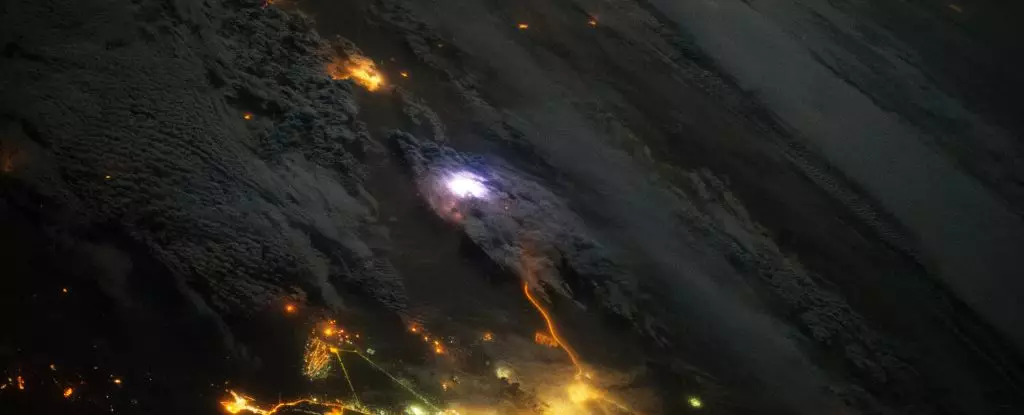Lightning stands as one of nature’s most awe-inspiring phenomena, painting the sky with stark flashes of light and reminding us of both its beauty and ferocity. Yet, recent research has illuminated an extraordinary connection between lightning storms and the delicate balance of particles surrounding Earth. This relationship not only sheds light on the interaction between terrestrial and cosmic phenomena but also opens doors for enhancing the safety of space missions and satellite technology.
Lightning storms are not merely confined to the immediate environment; they generate influences that ripple through the skies and beyond. According to findings from the University of Colorado, Boulder, lightning can catalyze a reaction that releases high-energy ‘killer’ electrons from Earth’s Van Allen radiation belts. These particles, possessing energies so great that they approach the speed of light, are not harmless. Instead, they pose a significant risk to satellites’ electronic systems and have the potential to cause health hazards for astronauts operating beyond Earth’s atmosphere.
The Van Allen radiation belts function as a protective shield, formed by the Earth’s magnetic field, which captures charged particles expelled by the Sun. But while these belts act as barriers against potential threats from solar winds, they are not impenetrable. The so-called killer electrons can breach this protective shield, demonstrating how interconnected our atmospheric events are with space weather phenomena.
The term ‘killer electrons’ evokes a sense of danger, and for good reason. These exceedingly energetic particles can penetrate satellite structures and jeopardize electronic circuits, which are crucial for operations in low-Earth orbit. Beyond technological ramifications, they also pose a threat to human life; astronauts exposed to heightened levels of radiation face increased risks of long-term health consequences, including cancer.
Interestingly, while we often associate high-energy electrons with hazardous outcomes, in certain medical applications, such electrons are exploited for cancer treatment. This primary distinction highlights the paradox presented by killer electrons; they can either be a tool or a peril, depending on the context in which they are encountered.
Lightning’s Unintentional Influence
The relationship between lightning strikes and the generation of killer electrons is a recent and intriguing discovery. Researchers meticulously analyzed satellite data gathered over a decade and were astonished to find 45 incidents of high-energy electron surges plausibly linked to lightning activity. These sudden bursts of energy, emerging within a fraction of a second after a lightning strike, suggest a complex interplay between terrestrial and extraterrestrial mechanics.
Traditionally, the inner radiation belt was deemed a stable zone, lacking the dynamism associated with outer regions subject to varying solar activity. However, the newfound link to lightning indicates that this region may, in fact, experience episodes of instability triggered by atmospheric phenomena. This revelation not only challenges existing assumptions about radiation belt behavior but also underscores the necessity of ongoing research in examining how Earth’s weather can orchestrate events in the space environment.
The Mechanisms Behind the Connection
Central to this phenomenon is the concept of whistler waves—low-frequency electromagnetic waves generated by lightning. Existing studies suggest that these waves can interact with the plasma within the radiation belts, escalating lower-energy electrons to relativistic speeds through a chain reaction of energy transfer. The implications are profound, as they indicate that the thunderous storms occurring miles above us can act as catalysts for complex and potentially hazardous activities occurring thousands of kilometers above.
Moving forward, identifying the range of factors influencing this relationship will be paramount. Solar activity, plasma density, and the nature of the waves generated during lightning storms could all play essential roles in determining the frequency and intensity of killer electron emissions. Continuous research and advanced observational techniques will be required to ascertain these variables and refine our understanding of lightning’s role in space weather dynamics.
Implications for Space Exploration
As we advance further into the cosmos, the safety of astronauts and the efficacy of our satellite systems must remain a priority. Understanding the ways lightning can summon killer electrons emphasizes the necessity of implementing protective measures during atmospheric storms. For those involved in space missions, the findings may necessitate a shift in preparedness protocols, emphasizing the importance of monitoring Earth’s weather patterns and their potential cosmic repercussions.
Ultimately, the electric dance between lightning and high-energy particles reveals the intricacies of our planet and the broader universe. The forthcoming explorations in this intersection of Earth and space weather not only enrich our understanding of scientific phenomena but also enhance the safety of our ventures into the final frontier.

